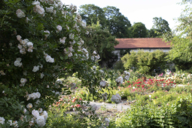
Rosengarten is a peaceful oasis not far from the Isar river – and it remains something of a hidden gem, despite this central location. It's a place where you can relax in absolute tranquillity; taking a seat on a wooden bench or metal stool, or simply stretching out on the grass to drink in the scent of the roses growing all around. We go for a stroll in a very special Munich park.
Apart from the plants, the people are the most exciting thing in Munich's Rosengarten. There are few places in the city where the very-young and the very-old sit, lie and stroll in such close proximity. With chairs and benches scattered all over the 4,500 square metres that this huge, wildly beautiful garden spreads across, many older people come here to sit and browse through books and newspapers at the first sight of sunshine, while under the cherry trees in the centre of the park, families gather for picnics and children’s birthday celebrations. And if you’re expecting a baby, here’s an insider tip and reason to visit the Rosengarten: it's a great place to discover an unusual baby name.
That’s because the main section of the garden alone is home to 8,500 roses from over 200 species, bearing melodious names such as “Lupo”, “Caramella” and “Pepita”. Each plant here – not just roses, but every tree and bush – is painstakingly identified with a nameplate. This feature has proven valuable not only to botany enthusiasts: eager young children can sometimes be spotted practising their reading too.
You don't even have to be a nature-lover to feel at home in the Rosengarten. It's enough simply to like people – although the splendour of the plants is likely to move even the most die-hard city slicker. This is no strictly manicured English-style garden, but rather a wild and diverse space separated into many sections, each one unique. Wandering through these sections you’ll find roses, as you might expect, but also themed gardens that delight all the senses. The Fliedergarten (lilac garden) is a scent and touch garden for blind visitors, and a bower of heady fragrance when in full bloom. Then there's the fenced Giftgarten, or garden of poisons, which children find endlessly alluring – no wonder, given that it is guarded by an extra gate with a big red warning sign describing it as “A teaching garden for poisonous plants from field, meadow and garden”.
The clear text on the information cards that accompany each of the poisonous plants really fires the imagination – for young and old readers alike. Whenever a city gardener passes by in green overalls, wearing a sun hat and carrying a garden hose or shovel in their hand, you feel as though you have been transported to a different, almost magical world – even though you’re actually still on the busy Wittelsbacherbrücke (bridge), surrounded by honking cars, bicycle bells and visitors to the Isar.
Today's Rosengarten, located on Sachsenstrasse between Schyrenbad and Isar river, was originally part of the Bischweiler Municipal Nursery, a facility planned by City Gardens Director Jakob Heiler in 1901 as part of the grounds along the Isar – and from those beginnings, this is still where the ornamental shrubs for the city’s flower beds are cultivated today, in the rear section of the park. The Rosengarten itself was planted in 1955. The idea was to try out various plants for use in municipal flower beds, to determine how they tolerate Munich’s climate and therefore whether it would be worthwhile to introduce them more widely. Between 1986 and 1989, the city's Building Department extensively redesigned the Rosengarten with the aim of showing interested visitors how professionals arrange roses.
It has stayed in that form to this day: it has never been groomed or perfected as a garden, but has always grown naturally so in places it looks a little enchanted now. The fact that the magic of the Rosengarten is now freely accessible for anyone to enjoy is truly a gift to all – locals and visitors alike. Behind the Rosengarten is a little stream that has been a much-loved secret water playground for Munich's toddlers for some years now. And if you want to linger for a while but don't have a book with you to read, you're sure to find something on the free book exchange shelves beside the Giftgarten.
But the most beautiful thing about the Rosengarten – or to give it its official title, the “Schaugärten an der Sachsenstraße” (“Show gardens on Sachsenstrasse”) – is perhaps neither the roses nor the people, but rather the trees. The park is strewn with innumerable varieties – large, small, broad, slender, crooked and poker-straight – which murmur soothingly as the breeze moves through their crowns.
Beech trees bending towards each other form an arch that makes you feel rather regal as you pass under it. And there's a funny drooping laburnum. The chestnut with the botanical name “aesculus neglecta, erythroblastos”, also known as the Carolina horse chestnut, is a rare jewel that wows visitors with its colours:
in spring its leaves are bright pink, then they turn green before changing again to yellow in the autumn. The empress tree and the dove tree are two other wonderful sights. If there's any way to do it, everyone should visit when the magnolias are in bloom. There are many varieties in the rear section of the garden, near the Isar. On a very few days, usually in March or April, they produce such magnificent blossoms in a range of pink, yellow and white hues that it will take your breath away. Some blooms are as big as your hand, while others are so delicate that they disappear with the first rain: nature’s most lavish luxury. You'll find beautiful-sounding names here, too. If you ever meet a Munich child named “Lennei”, it might be “Lennei – like the magnolia”.